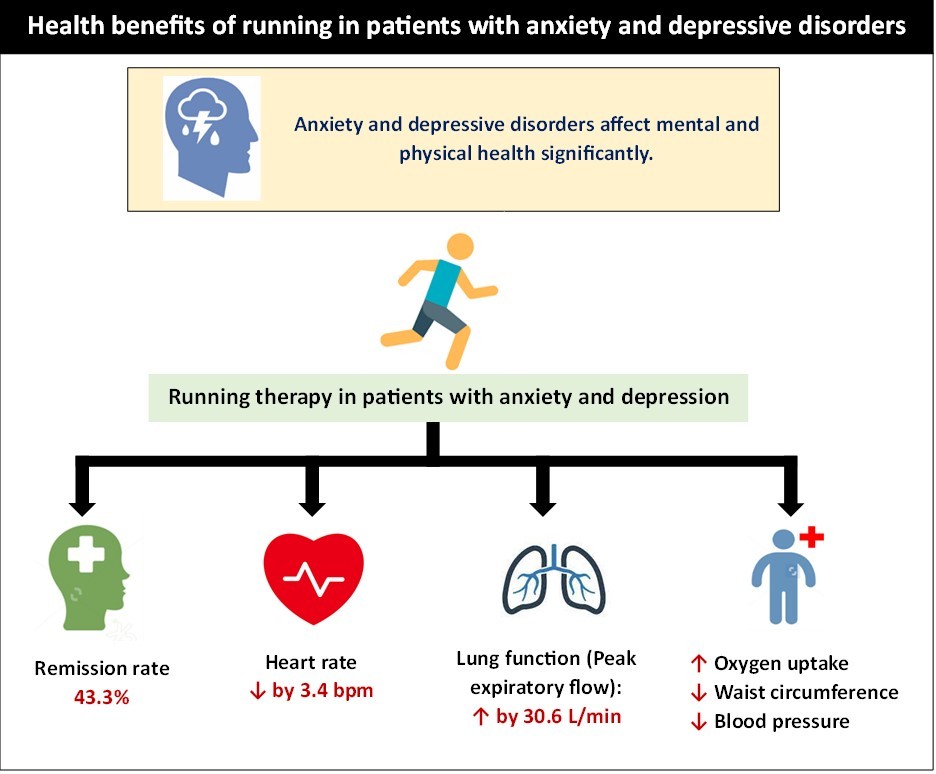
Depressive and anxiety disorders often take an immense toll on the mental and physical well-being! Results from meta-analyses indicate that exercise interventions can be as effective as antidepressants and psychotherapy, especially for managing mild-to-moderate depression. Given the higher risk of physical illnesses like cardiovascular disease, diabetes, and obesity in people with depression and anxiety, it is necessary to identify treatments or interventions, which promote physical health and can help in preventing associated diseases. It may also help in understanding therapeutic mechanisms of physical interventions and tailoring these interventions to specific patient groups. However, the impact of exercise interventions on physical health of individuals with psychiatric conditions remains underexplored.
A recent study by Verhoeven et al., published in the “Journal of Affective Disorders”, reported that exercise therapy, particularly running, is beneficial for both mental and physical health and should be a part of daily routine of people with depression and anxiety disorders.
This “MOod Treatment with Antidepressant or Running (MOTAR)” study was a 16-week partially randomized pragmatic trial involving 141 adult participants, aged between 18 and 70 years with depression and anxiety disorders, as determined using the DSM-IV algorithms with the Composite International Diagnostic Interview. Participants underwent baseline and post-treatment assessments, which included blood tests, recording the demographic information, psychiatric interviews, physical examinations, and self-reported questionnaires. The severity of depression and anxiety were assessed at Weeks 6 and 10. Treatment allocation was partially randomized, with some patients allowed to choose their preferred treatment. The antidepressant group received escitalopram (10 mg per day), while the running therapy group was engaged in a supervised 45-minute outdoor running sessions for 16 weeks (2–3 times a week). Running intensity was adjusted based on heart rate, and adherence to the running therapy was denoted by completing at least 70% of the prescribed sessions. Mental health outcomes (the status of depressive and anxiety disorders and their severity), and physical health outcomes (biomarkers, heart rate variability, blood pressure, fitness levels) were examined.
The study results are summarized below:
- Out of the 141 participants, 45 patients received antidepressant medication and 96 patients underwent running therapy.
- Treatment adherence was significantly higher in the antidepressant group (82.2%) compared to the running therapy group (52.1%).
- As per the intention-to-treat analyses, remission rates at Week 16 were 44.8% in the antidepressant group and 43.3% in the running group (p = 0.011).
- Both treatment groups showed significant decrease (from the baseline) in depressive and anxiety symptoms after intervention, even in those who reached remission.
- Participants in the running therapy group experienced more favorable changes in various physical health outcomes, viz., weight (-0.6 kg; p = 0.001), waist circumference (-1.6 cm; p = 0.011), systolic blood pressure (-2.5 mmHg; p = 0.011) and diastolic blood pressure (-2.9 mmHg; p = 0.002), heart rate (-3.4 bpm; p = 0.033), and heart rate variability (1.2; p= 0.006), compared to the antidepressant group.
- Improvement in metabolic syndrome components were noted in the running therapy group while these parameters deteriorated in the antidepressant group.

Clinical implication
- This study underscores the significance of regular exercise in promoting both mental and physical health in individuals with depression and anxiety disorders. Given the favorable physical health outcomes associated with running therapy (see Graphic), clinicians should consider exercise therapy as a standard and valuable component of mental healthcare.
- The study also emphasizes that clinicians should be aware of the potential physical health consequences of antidepressant medication. Regular physical health assessments and interventions may be necessary to mitigate the risks associated with antidepressant use.
- There is a rising need for more individualized treatment approaches in the field of mental health. By identifying patient subgroups with specific biological dysregulations, such as high inflammation levels, healthcare providers can tailor treatment recommendations, accordingly.
(Source: Verhoeven JE, Han LK, Lever-van Milligen BA, Hu MX, Révész D, Hoogendoorn AW, Batelaan NM, van Schaik DJ, van Balkom AJ, van Oppen P, Penninx BW. Antidepressants or running therapy: Comparing effects on mental and physical health in patients with depression and anxiety disorders. J Affect Disord. 2023;329:19-29. Doi: 10.1016/j.jad.2023.02.064)
